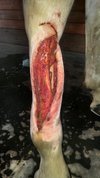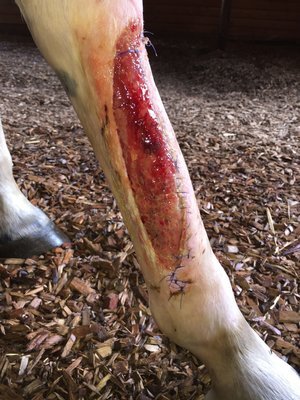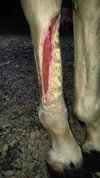Class IV Laser Therapy: Helping the Equine Patient
by Sylvia Ouellette, DVM, Diplomate ABVP
Laser therapy has been around for decades but has gained popularity in equine medicine in the last few years. What is laser therapy? Lasers use light energy to stimulate the tissue in the body to heal. The unit of energy that is delivered is a Joule. Each laser is designed at a different Wattage and wavelength that will deliver the Joules that you need depending on the amount of time used on a specific area. Cold lasers are defined as a laser that delivers 0.5 Watts or less. Anything over 0.5 Watts is considered a class IV laser. Surgical and cutting lasers are also in the same category as class IV. At our clinic we utilize a 15 Watt Class IV laser. It allows us to deliver therapy with a deeper tissue penetration and in a shorter amount of time. Research has determined how many Joules are needed to treat certain problems in the horse and that is what dictates how long and what Wattage we need to use. Why do lasers work? The simplified version is that the cells absorb light and stimulate the mitochondria within them to produce Nitric Oxide (among other factors) which increases energy production and initiates a cascade of local and systemic therapeutic signaling which increases cell activation, growth factors, inflammatory mediators and expression of protective anti-apoptotic (anti-cell death) proteins. The results of this cascade of events is what leads to increased healing in chronic wounds, decreased inflammation and pain reduction. Lasers are helpful in reducing inflammation in both acute and chronic conditions, such as tendon and ligament inflammation or tearing, chronic osteoarthritis, and joint or tendon sheath swelling. We have also had great success in healing extensive wounds and lacerations with minimal swelling in a reduced amount of time. The wound below is an example of healing using only Class IV Laser therapy in the areas that could not be sutured. No skin grafting was necessary to close this wound, and other than daily bandaging, the laser helped to reduce the inflammation and continue to help the skin heal over the gaping wound within only a couple of months. Give us a call here at Oakhurst if you think your horse might benefit from Laser Therapy 503-554-0227, or email to office@oakhurstequine.com
Picture number 1 is the original injury - June 16, 2016. Note the bone is exposed. Picture number 2 you see tissue is completely covering the bone - July 6, 2016. And in Picture number 3 only a small portion is left to heal - September 1, 2016.



